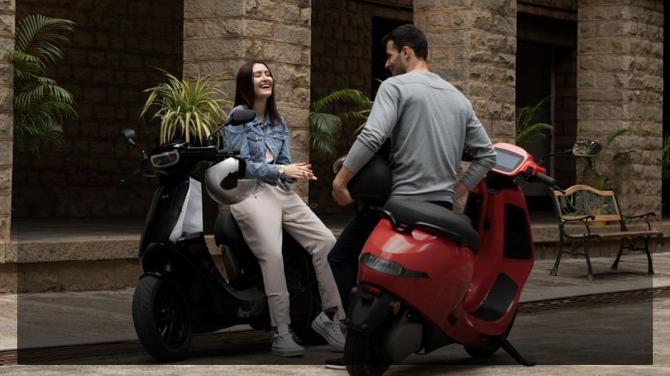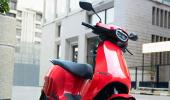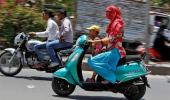Dubious chargers, poor battery placement and faulty wires are some of the culprits.
India’s safety ecosystem is a black hole.
Rigorous testing is needed for Indian conditions — beset with volatile grids, broken, bumpy roads and careless consumers.
S Dinakar reports.

Nearly a decade ago, the first fully electric vehicle (EV) caught fire on the road in the US.
It was a model from Tesla, the world’s most admired EV maker.
A metal fragment punctured the underbelly of the vehicle, penetrating its battery pack, leading to a fire.
Indian lawmakers and automakers have had nine years to study the incident (in fact, three Tesla Model Ss caught fire in two months in 2013) but seem to have learnt little.
Otherwise, we wouldn’t face a spate of fires involving EVs.
The latest occurred in Hosur (Tamil Nadu), when flames emerged from under the seat of a scooter — where most Indian electric two-wheeler (E2W) makers stash a battery, often encased in heat-absorbing black plastic and with little ventilation.
When you pack a lot of chemical energy into a small space, the chances of explosions are high.
Lithium-ion, the world’s most popular battery technology, is used from phones to vehicles.
Used properly, accidents are rare, but, if compromised, it is a ticking bomb.
“Lithium has a natural affinity for fires’’ said Amit Das, founder, Electric One, a multi-brand EV franchise store chain, adding, “The behavioural usage of batteries by consumers matters a lot.”
There is no official count of EV fires because the government and industry bodies don’t collect such data.
One has to rely on media reports to collate accidents in a country that aims to transition to a clean air paradise.
Ola Electric, Okinawa, Pure EV and Boom Motors made around 7,000 recalls after incidents of flaming vehicles emerged since last September, and after transport minister Nitin Gadkari warned of penalties.
“It’s not mandatory to do a product recall,’’ said Hemal Thakkar, director, Crisil Research.
“Even now, after so much pressure from the government, there are only certain OEMs recalling only a certain number of vehicles.”
But as Abhijeet Sinha, project director, NHEV, an EV solutions consultancy, pointed out, “Recalls must happen before the fires, based on data collected from batteries.”
While India has adopted the AIS156 standard to ensure safety, a lot more needs to be done to ensure EVs become safer, industry officials said.
India’s safety ecosystem is a black hole.
Officials react only after crises.
Gadkari ordered the Defence Research and Development Organisation (DRDO) to investigate the accidents, demonstrating an institutional vacuum at the transport ministry, which is being forced to rely on a defence agency to investigate an EV fire.
When you open the website of US National Highway Traffic Safety Administration, which investigates accidents, ratings and recall pop up.
Enter any model and get a history of incidents and quality comparisons.
Indian counterpart Automotive Research Association of India (ARAI), the authority on testing and reporting, is tight-lipped — the website does not define details of standard tests done to certify vehicles nor is there any guidance for consumers to make informed decisions on which brand is safer.
One of the problems is the lack of standardisation.
As a result, companies send a good model for certification but subsequent batches may have inferior units, Sinha said.
With over 400 EV models in the market, there’s a need to standardise batteries for safety and performance, he added.
More so in India’s fragmented EV market, where big manufacturers jostle with minions and traders for a slice of the $200 billion opportunity by 2030.
Most treat E2W manufacture like a kid assembling a Lego game — import cells and components from China, pack, and arrange them in a shell.
There are no penalties if something goes wrong.
“It’s like a toy business,’’ said Shrikant Shinde, founder and CEO of Mumbai-based EV service provider GoGoA1, which is now testing some EV fleets for quality.
In relative terms, the number of EVs going up in flames is still minuscule compared to over 230,000 units sold last fiscal.
Of several thousand E2Ws sold by Ola, Pure EV and Okinawa, reports cite less than a combined 10 units involved in fires.
Twenty units of Pune-based Jitendra EV caught fire during transportation.
But lives were lost, as when Pure EV’s battery exploded in a house in Telangana, or when a Boom Motors battery burst while being charged in a bedroom in Vijayawada.
Ola, Pure EV and Okinawa did not respond to emailed queries.
“It’s important that sales and service people are educated about the basics of a battery, and, in turn, inform consumers,’’ said Awadhesh Jha, executive director, Fortum, a Nordic mobility operator. “Charging a battery at home is like sleeping in a house with a petrol tank.
"I would never recommend taking a battery to the bedroom.”
Battery fires only occur in the event of a short circuit, when temperatures cross 150 degrees centigrade, said Arun Vinayak, co-founder & CEO, Exponent Energy, an advanced battery maker and charging technologies start-up.
Temperatures over 65 degrees only affect performance and battery life.
A short circuit can occur internally, among the cells, either from poor design or bad quality components, like cheap, inconsistent separators, or if the battery management system, the brain, is ineffective. Vibrations can displace poorly welded bolts in batteries, causing shorts.
Dubious chargers, poor battery placement and faulty wires are other culprits.
Rigorous testing is needed for Indian conditions — beset with volatile grids, broken, bumpy roads and careless consumers.
An EV that works in the Netherlands may not work in India, Vinayak, part of the founding team at E2W maker Ather Energy, said.
Inconsistent quality can also be a function of competitive pressures.
For instance, Ola Electric acquired Amsterdam-based Etergo, an E2W scooter OEM in 2020, and opened bookings last year.
It now faces fires, irate customers cribbing over performance and range anxieties, and allegations of a Twitter-led customer service.
Recently, Sun News reported an S1 pro owner setting his scooter on fire in Chennai, upset with the performance.
There are exceptions. Ather and Hero Electric, India’s largest EV company by sales, have stayed incident-free so far.
Ather spent five years in vehicle development, testing units over one million km, a spokesman said.
The home-grown platform was tested across India, extreme temperatures, dust, and for road vibrations.
For instance, Ather’s battery is in its underbelly, cased in aluminium, flat, water resistant, and tightly packed as in a Tesla.
Ather has plush experience centres where sales staff encourage test rides.
Ola’s e-presence does not offer ready options to test drive a Rs 1 lakh scooter.
Akash Gupta, co-founder & CEO, Zypp Electric, a last-mile delivery service, mainly uses Hero Electric EVs in his fleet of 4,000.
His vehicles typically make 800,000 deliveries a month, covering over 300,000 km and, so far, have stayed incident-free.
Gupta also chose a lithium ferrophosphate (LFP) battery for his fleet, which has lower energy density but is relatively more robust and stable compared to a more advanced lithium nickel manganese cobalt oxide cell, delivering higher currents but more reactive.
Informed choices like this may help reduce accidents in the future.











